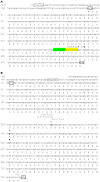MutS and MutL are dispensable for maintenance of the genomic mutation rate in the halophilic archaeon Halobacterium salinarum NRC-1
- PMID: 20140215
- PMCID: PMC2816208
- DOI: 10.1371/journal.pone.0009045
MutS and MutL are dispensable for maintenance of the genomic mutation rate in the halophilic archaeon Halobacterium salinarum NRC-1
Abstract
Background: The genome of the halophilic archaeon Halobacterium salinarum NRC-1 encodes for homologs of MutS and MutL, which are key proteins of a DNA mismatch repair pathway conserved in Bacteria and Eukarya. Mismatch repair is essential for retaining the fidelity of genetic information and defects in this pathway result in the deleterious accumulation of mutations and in hereditary diseases in humans.
Methodology/principal findings: We calculated the spontaneous genomic mutation rate of H. salinarum NRC-1 using fluctuation tests targeting genes of the uracil monophosphate biosynthesis pathway. We found that H. salinarum NRC-1 has a low incidence of mutation suggesting the presence of active mechanisms to control spontaneous mutations during replication. The spectrum of mutational changes found in H. salinarum NRC-1, and in other archaea, appears to be unique to this domain of life and might be a consequence of their adaption to extreme environmental conditions. In-frame targeted gene deletions of H. salinarum NRC-1 mismatch repair genes and phenotypic characterization of the mutants demonstrated that the mutS and mutL genes are not required for maintenance of the observed mutation rate.
Conclusions/significance: We established that H. salinarum NRC-1 mutS and mutL genes are redundant to an alternative system that limits spontaneous mutation in this organism. This finding leads to the puzzling question of what mechanism is responsible for maintenance of the low genomic mutation rates observed in the Archaea, which for the most part do not have MutS and MutL homologs.
Conflict of interest statement
Figures




References
-
- Harfe BD, Jinks-Robertson S. DNA mismatch repair and genetic instability. Annu Rev Genet. 2000;34:359–399. - PubMed
-
- Schofield MJ, Hsieh P. DNA mismatch repair: molecular mechanisms and biological function. Annu Rev Microbiol. 2003;57:579–608. - PubMed
-
- Iyer RR, Pluciennik A, Burdett V, Modrich PL. DNA mismatch repair: functions and mechanisms. Chem Rev. 2006;106:302–323. - PubMed
Publication types
MeSH terms
Substances
LinkOut - more resources
Full Text Sources

